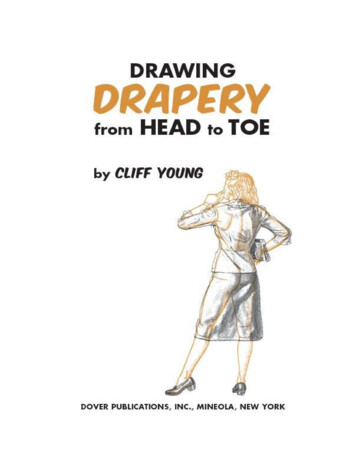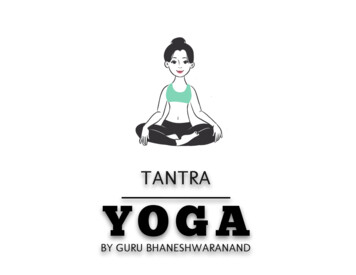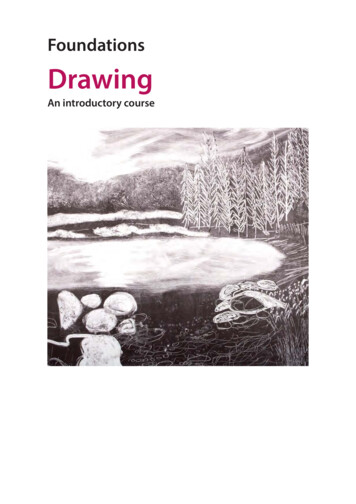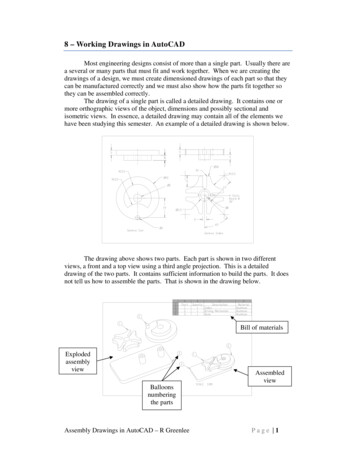![Drawing The Human Head Burne Hogarth[English] - Internet Archive](/img/29/drawing-the-human-head-burne-hogarth-english.jpg)
Transcription
DRAWING THE]HUMANHEADBurneHogartnProportionsHead TypesStructureAnatomyAgingFacial FeaturesMovement
DRAWING THEHUMAN HEAD
NineDRAWING HIEby me author of Dynamic AnatomyWatson-Guptill Publications/New York
To my wife Constance;to my children Richardand Ross, Michael and Mary.When these embers are reducedto ashes, who finally willknow its warmth?This is for them, after all.
TattleolContents
lliilllllill
Introduction
HsH
DRAWING THEHUMAN HEAD
1.BasicSinicinand Forms
GREAT MASSES
The cranial inand regular:Facial!The facial mass, on the otherhand, is uneven and irregular:a somewhat hard-cornered, tri-nial Mass,ee-Quarter Down ViewLower Jaw Form,Back View
The facial mass descends alongthe bridge of the nose. Atmass scoops sharply inwardand swings over the bulge ofthe teeth to the protrudingmound of the chin. From here,up the lower edge of the jawline to the angle of the jaw.Here it rises steeply, almostvertically, to the jaw hingein the base of the head. Theboundary line, connecting thehinge with the nose bridge, di vides the facial mass from the
Take the width of one of thehalves of the egg (C-D) andmeasure this against the ver tical centerline (A-B).If youhave drawn the egg properly,the center line (A-B) shouldbe three times the length of thehorizontal line (C-D). Thus,the total width of the head (CE) is just two thirds thelength. If your first drawingof the head shape is too longor too short, use these spacedivisions to eliminate the dis-
Drawing Cranial andFacial MassesThis series of drawings showshow to simplify the two majormasses when you draw difficultviews and extreme positions ofthe head. What is most im portant in this first stage is toset down a firm and correctfoundation upon which to buildthe smaller forms. Specific de tails of these smaller forms areleft for later refinement. Seehow easily a difficult view ofthe head may be solved bystarting the drawing with theinitial placement of the twogreat masses. Note the flatnessof the under-jaw and skull base.Back ViewThree-Quarter Top View
III!!!
OCCIPITAL BONE
(1)
rSaraDdarChedt Ward
ProportioMeasurenThe middle of the brow ridge,at its base, is the depressedbridge of the nose. This is theexact midpoint of the head.Here, at the midway line, thehead is five eye-lengths wide.Tl* brow ridge itself is fourCentrally located in the facialmass, the tapered wedge of thenose descends to a point mid way between the bridge of thenose and the base of the chin.The width of the nose at itsbase is equal to the width of the
The base line of the cheek bonealigns with the base of thenose. In frontal views, the in ner depression of the cheekbone is roughly midway alonga diagonal line (30 degrees)from the eye socket to theangle of the jaw.
The side arch of the cheek bonestarts at the lower rim of theeye socket, and aligns with themidpoint of the nose. The archends just below the middle ofthe ear, in line with the backedge of the jaw.The ear begins at a line drawnup from the rear edge of thejaw. The ear base aligns withthe base of the skull, the baseof the nose. The top of the earaligns with the protrudingbrow ridge. The peak of theeyebrow hair will identifythe height of the ear, in rela-
w
These points, joined with aline, show the oblique axis ofthe eye. The eye opening is nota symmetrical almond shape.High and Low Points of EyeAxis of Eye:Three-Quarter Down Vie\Axis of Eye:Three-Quarter Up View
EYE MUSCLE FORMATION Surrounding the entire eyeis a large, widespread, ovalmuscle: the orbicularis oculi.Eye Muscles,Greatly CompressedEye Muscles,Partially Compressedorbital part, which encirclesthe entire eye socket from thebrow ridge down to the middlecheek bone; and the palpebralpart, the eyelids, which encasethe eye itself. Both parts ofthe orbicularis muscle closethe eye by compression. Thegreater orbital part vigorouslycontracts the region around thesocket, while the eyelids cur tain the eye briskly but gently.Eye Muscles
Nosetriangular, wedge-shapedblock, narrow and depressed atits root under the brow ridge,broad and prominent at itsbase in the mid-region of theThree-Quarter Up VThree-Quarter Down ViewThe nose consists of four im portant forms: the upper nasalmass, with its supporting nasalbone and upper cartilage; thelower elliptical ball of the nose,the alar cartilage with itscurved hook (the septum);the two sidewise, expandingnostril wings, the ala carti lages, triangular in shape andjoining the projecting ball toform the nostril cavities in the
Side Vie
Septal Cartilage
MouthThe substructure of the mouthis formed by the two great den tal arches of the teeth: the up per (maxillary) arch and thelower (mandibular) arch. Settogether, both arches supportthe curving mouth barrel.SIDE VIEW PROPORTIONSFRONT VIEW PROPORTIONSthe base of themouth bulge drops tthe dislThe outermost points of thedental curve align with thecenters of the eye sockets.
The lower lip is more a.and mobile than the uppeiFfil’sFi'INDIVIDUAL VARIATIONSThis generalization obviouslydoes not apply to individualswith an outthrust lower jaw.In such cases, the lower lip pro trudes and the upper liplower jaw guarantees grtactivity. The lower lip ismoved by an ample set of lowermouth, chin, and jaw muscles.
The entire ear lies within twolines drawn from the top of theeyebrow and the base of thenose. The ear divides verticallyFirst part: from the top of theear to the point where the helixattaches to the side of the head.Second part: the mid-region ofthe ear is occupied entirely bythe bowl (concha). The tragusis at the exact midpoint of theThird part: the lobe of theear. The bottom of the lobealigns with the base of theWIDTH COMPARED TO LENGTHThe width of the ear is halfthe length. This measureoccurs only at the highest partof the ear, the helix or outer
Back Wall of Ea
2.HeadMovement
Proof of MethodLet us, for the sake of argu ment, raise an important ques tion: Is the foregoing methodreliable for any stage in therotation of the head? It is.Here is the proof. Suppose thatwe wish to give the head itsgreatest possible rotation,from a front view to a full sideview. First, we draw the frontovoid shape and divide it, asbefore, in halves. We then takethe measure A-B (half thewidth of the front view head)and transpose it to C-D, whichcompletes the cranial mass.Finally, we sketch in the fullprofile. Our method gives us agood side view head. But is itproportionally correct? RecallChapter 1, in which we demon strated that the side view headdivides vertically into threeequal parts. Measure the abovehead: A-B, B-C, and C-D areFour Views of Headin RotationWhen you have mastered theprocedure, try it on a series ofheads showing various turnsto left and right. In all views,note how each measure A-Bequals measure C-D.Greater Turn to Lefty\\\\v\i y\Slight Turn to RightVery Great Turn U Right
UP AND DOWNMOVEMENT OF HEADThe brow line, which lies acrossthe middle of the head at thebridge of the nose, is the hori zontal axis of the head. Belowthis line, the facial mass be gins. All up and down move ment of the head starts withthis line. If the head tips down,the axis line drops; if the headlifts up, the line rises.How Movement Affectsthe Brow Line
3.racialChange:wrinkles
In Chapters 1 and 2, the headhas been seen as a standard,generalized structure. The dis cussion has been limited toaverages and similarities of allheads. We shall now proceedto the factors which determinefacial differences. In the nexttwo chapters, we shall exploretwo forms of facial change:wrinkling and aging.THREE WRINKLEPATTERNSWrinkling of the face occursfor a variety of reasons. Theincidental facial activity, suchas chewing, grimacing, wink ing, pouting, squinting, ex pressions of pleasure and dis taste, and demonstrations ofto psychological stress and in ner tensions, as well as aging,muscular flaccidity, or loss offirmness in flesh. Whatever theorigin of wrinkles, their de velopment follows three majorpatterns: frontal, oblique, andFrontal PatternThe frontal pattern of wrinklesis heavily concentrated in thex 1 region of the face. ThisBK
The oblique pattei i begins inthe deep inner cur ! of the eyesocket below the no ; root. Twowrinkle movemen 5 develop:ring edgesir eye andover thecheek; above, the pattern movesfrom the socket curve over themid-brow to the base of theforehead.
ASCENDING MOVEMENTThe wrinkles rise from thecompression line of the eye brow and inner socket. Thenthey range up and outward inturns and ends in a series oflower forehead.
INTERACTION OFWRINKLE PATTERNSThe three major wrinkle patindependent or compartmen talized. In these four examples,observe the groupings and then94ParaUel Effect ofPressure and TensionAn expression of concentrationcauses pressure wrinkles toappear between the eyebrows.At the same time, incipient ten sion folds develop on the sideof the mouth and cheek.When the head is thrust force fully into the neck, extremepressure creases girdle the en tire perimeter of the lower jaw
4.FacialChange:Aging
YEAR
3'/z-4 YEARSProportion: facial mass (stillincreasing), 1 part; cranialmass, 2y2 parts. S-curve offorehead and nose persists.Nose slightly longer. Cheekfull and rounded. Jaw larger;chin curved, somewhat prom inent. Under-jaw fat and neckfat disappearing; neck longer.Lips firmer; mouth more com petent and expressive.6-7 YEARSProportion; facial mass (stillincreasing), 1 part; cranialmass, 2 y;i parts. Orbits almostas large as adult. Nose stillcurved, but longer; tip up thrust. Mouth region larger.Chin round, more prominent;jaw angle more vertical; jawlarger. Neck longer. S-curveof rear head bulge and neckevident. Hair unruly, thicker,
14-15 YEARS
fSlilli35 YEARS
45 YEARSHair thinner, graying and re ceding at temples. Definiteforming at outer corner of eye.Under-chin sag droops slightlytoward neck. Chin mound quitedistinct. Jaw corner fleshy, lesslean. Neck less firm; earlywrinkles starting on side; fleshon rear neck reflects increased50 YEARSFrontal hair thinned out; sidehair recessed. Grayness con tinues. Upper lid line sags. Eyedeeper-set in socket. Fleshypouch beginning under lowerlid. Wrinkles in mid-forehead.Deeper nose bridge. Cheekflesh sags; cheek bone evident.sinks toward neck. Jaw linefleshy and unclear. Neck wrin-4 N
80 YEARSSenescence and debility over take head from this stage andbeyond. Loss of teeth createsundershot bony look of jaw.Jaw angle quite low and flat.Mouth collapsed and wrinkled.Cheek sunken. Flesh witheredear and neck. Hair fine, thin,silky. Deep sag on upper lidline; upper eyelid droopsmarkedly. Generally feebleappearance.
s.HeadTypes
BROAD-HEADED(BRACHYCEPHALIC)Heads in this category arecharacterized by a wide skull,yet features and facial aspectsmay be remarkably varied.
Applying ProportionsIn drawing this type—or anyother—do not try to apply theproportions exactly. The draw ing is apt to become forced andstilted. If the head is visuallyhave produced an acceptablesolution. See how these threeamples of broad heads prHead ProportionsWhen you draw the broad headed skull, you may find thatthe width of the skull is atleast four fifths the length.Facial FeaturesIndividuals with medium tolow foreheads tend to have i-Hcompact, square, relatively
EXAMPLES OFHEAD TYPESNo one particular group ofpersons can be identified by asingle head type classificationdividuals of all populationgroups the world over. In thefollowing drawings, we shallsee a sampling of persons,
Southern India-Ceylon Man.Medium Head Type;Diagonal Facial Slope.
Eastern European Man(Ukraine): Broad Head Type;Steep Facial Slope.Central African Pygmy(Congo): Broad Head Type;Diagonal Facial Slope.North African Man (Berber,Morocco): Long Head Type;Steep Facial Slope.North American Eskimo Man(Arctic Fringe): MediumHead Type; ModerateFacial Slope.
Asm Minor Woman(Turkey): Medium HeadType; Moderate Facial Slope.West African Man (Nigeria):Long Head Type;Moderate Facial Slope.
(Spain): Long Head Type;Steep Facial Slope.Western United States IndianMan (Sioux): Broad HeadType; Moderate Facial Slope.Northeastern AustralianMan: Long Head Type;Moderate Facial Slope.Central African Woman(Congo): Long Head Type;Diagonal Facial Slope.
Polynesian Man (Samoa):Broad Head Type;Moderate Facial Slope.
6.GalleryolGreatHeads
PORTRAIT OP AN OLD MANMarble SculptureRoman, First Century B.c.The Metropolitan Museumof Art, Rogers Fund, 1921.This lean, long-jawed indi vidual presents an excellentexample of the frontal wrinklepattern which emanates fromthe narrow nose root at thebridge and the nostril wings atthe base. The wrinkle patterncan be traced in the verticalcompressions that start fromthe eyebrows and engage thehorizontal forehead furrows.Then the pattern emerges fromthe nose wings and coursesdownward, holding to the pe rimeters of the mouth bulgeThis trenchant portrait, withits gaunt face and narrow cra nial box, gives us an explicitspecimen of the long-headed ordolichocephalic skull form.HEAD OF A MANMarble SculptureRoman, First Century B.c.(Late Republican Period)The Metropolitan Museumof Art, Rogers Fund, 1917.Despite the missing fragmentof the nose, this head clearlyshows the emerging wrinklepatterns of the nose. Note howthe oblique pattern, startingfrom the inner corner of theeye and moving into the mid face, is distinguished from thefrontal pattern, which turnsaround the nostril wing andholds to the lower cheek con tour. The wide-set lateralwrinkle group, beginning atthe outer eye corner, radiatesupward to the forehead anddownward to the extreme edgeof the jaw and neck.Of the three generic classes ofhead type, this version appearsto be a remarkable example ofthe broad-headed or brachy-EMPEROR CARACALLAMarble SculptureRoman, Third Century a.d.The Metropolitan Museumof Art, Samuel D. Lee Fund,The upward direction of theoblique wrinkle pattern is pre sented with incisive clarityin this portrait. The patternthrusts from across the nosebridge and projects angularlyover the brow to merge with thefurrows of the mid-forehead.This vigorous accent is no overvealing psychological tensionin the imperious characteriza tion of the emperor’s personal ity.In an over-all classification,this head can be assigned tothe intermediate or mesocephalic skull type, wherein thegeneral configuration of thecranium is neither broad nor
PORTRAIT OP A YOUNG MAN(PERHAPS AUGUSTUS)Marble SculptureRoman, Augustan Period(ea. 30 B.C.)The Metropolitan Museumof Art, Rogers Fund, 1919.PORTRAIT OP AN UNKNOWNMAN (DETAIL)Pencil on paperJean-Auguste DominiqueIngres (1780-1867)The Metropolitan Museumof Art, Rogers Fund, 1919.This profile view confirms themeans by which the front neck line is established under thejaw. A line starting from thetip of the nose, touching thelips, and continuing down ward strikes the forward pro jection of the laryngeal box orA penetrating simplicity emer ges in a drawing developedfrom a single source of light.In this manner, Ingres showsthe massed side plane of thehead, with the shadow edgingthe depressed temple wall andthe emerging cheek mound.the triangular nose wedge. Themouth bulge is more subtly ex pressed ; since the subject is anis of incipient shrinkagewrinkles. The upper head massis drawn in a linear shorthand;the stroked modeling of thehair explains the cranial vault
(147 1564) Bu narr0tlThe Metropolitan Museum ofArt, Purchase, 192b, JosephPulitzer Bequest.In this overview of the head,Michelangelo turns the posi tion almost into a profile whiletipping the mass over to itsside. This subtle attitude is as serted with a number of smallbut decisive clues. Just abovethe nose bridge, he shows thefar brow bulge. On the eye,the arc of the upper lid domi nates the lower and tends toforce the orb deep into thesocket. The swing of the upperlip curve goes beyond the cen ter groove and rotates theright produce a box-like effectwhich further suggests theoblique tilt. The spiraling neckwrinkles show the twist of thehead in our direction. Thistwist is confirmed by the si multaneous lift of the shoulderin reverse, which confirms thewrench-tilt position.Albrecht Diirer (1471-1528)The Metropolitan Museum ofArt, Fletcher Fund, 1919.The modeling process, as Durer performs it, is almost likefine-spaced lines is stroked into extract the topographicalarray of forms and textures.He explores the undulantcourse of hair, the thick-setbrow, the heavy eyes, the broadnose, the full-hewn lips, theample chin, and the pendulousjowl. Form after form, he ex plores the relative sequence ofplanes in depth. But there is nopassage so perceptive as the in cisive probing of the mouth,chin, and jaw. The lips proand this joins the far-left con tour of the higher cheek. Theunder-mouth recess is inflectedagainst the thrust of the jutoutline into play toward theinner face. Below, the heavyjaw flesh swings from left toright under the dark curls.Then the rear neck fold reand complete the facial line. Hans Holbein the Younger(1497/98-1543)The Metropolitan Museum ofArt, Bequest of Benjamin AltThe development of depth inthis spare and meticulous headis accomplished by overlappingand playing out contrastingareas of tone. To this end, Hol bein takes advantage of athree-quarter view and pene trates the facial contour withthe incisive nose, the taut chin,the fine extension of the eye lash. Great curving arcs on theheadpiece produce a series ofturns like a tunnel throughwhich the head emerges; thenthe device is carried to theneckband to let the chin andjaw through, and to the neck lace and collar to ring the neckand shoulders. His modeling offorms is only incidental to hislinear effect, for his use of toneis introduced to support andenhance an overlapping edge.See how the tone on the chinbase and behind the nose linequalify these edges.
ADORATION OF THE MAGIPen and bistre drawingwith washGuercino (1591-1666)The Metropolitan Museum ofAH, Rogers Fund, 1908.In this spirited drawing, Guerplicity that aging is not merelya matter of wrinkling, but alsoa change in structural forms.In the disparate age levelsfrom the very young to thevery old, infancy and youthare revealed in fullness of fleshand roundness of forms, whilematurity and age are ex pressed in dryness of tissueand angularity of bony sup ports. The line only brieflymakes a concession to a wrinklehere and there, but it is thewash tone which puts the com pact volume of these heads inrelief. And it is this use ofmassed form and plane that
James Abbot McNeill Whistler(1834-1903)The Metropolitan Museum ofArt, Gift of George S. Heilman,At first glance, this seeminglypainting projects an immate rial, amorphous quality. Whilethe details may be vague, thereis nevertheless a studied unityin the assemblage of masses.The light play, expressed inthe intense upper right of thehat and cheek plane to thelower left chin and jaw. Thenthe slash of the mouth, the nosebase, the bearded chin, thetouches of eyes and ears areaffixed, and the whole is se curely inserted into the collar 147and shoulders. The fleeting,nondescript impression is dis pelled as the head takes on aplastic totality in space. Thehead solidly exists, though de in an atmospheric haze.
KiSSH55S-'SSSSsat
PORTRAIT OP HENRY BECQUEDrypointAuguste Rodin (1840-1917)The Metropolitan Museum ofArt, Rogers Fund, 1922.When a sculptor works out agraphic problem, his tendencyby chiseling and carving withline. Rodin, using a top-lightsubject, lays bare sculpturdelicately chips and scrapeshead light is used as a tool toexamine the relationships offormsto the variationstf texclarity.
Index
Tragus,
DRAWING THEHUMANHEADBurne HogarthCONTENTSBASICSTRUCTURESAND FORMSHEADMOVEMENTFACIAL CHANGE:WRINKLESFACIAL CHANGE:AGINGHEAD TYPESGALLERY OFGREAT HEADS
DRAWING THE] HUMAN . HEAD . BurneHogartn . Proportions Head Types Structure Anatomy Aging Facial Features Movement . DRAWING THE HUMAN HEAD . Nine . DRAWING HIE by me author of Dynamic Anatomy Watson-Guptill Publications/New York . This is for them, after all. Tattle . ol . Contents . lliilllllill. Introduction . HsH . DRAWING THE HUMAN HEAD .










